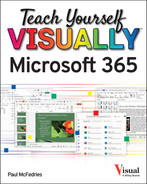CHAPTER 3
Microsoft 365 Graphics Tools
Insert a Picture from Your PC
You can illustrate your Microsoft 365 files with images that you store on your computer. For example, if you have a photo or graphic file that relates to the subject matter in your document, you can insert the picture into the document to help the reader understand your subject. After you insert a picture, you can resize and move the image as described in the section “Resize and Move Graphic Objects,” later in this chapter. You can also modify the graphic in a variety of ways, as described in the section “Understanding Graphics Modification Techniques,” later in this chapter.
Insert a Picture from Your PC

![]() Click in your document where you want to add a picture.
Click in your document where you want to add a picture.
Note: You can move the image to a different location after inserting it onto the page. See the section “Resize and Move Graphic Objects,” later in this chapter.
![]() Click the Insert tab.
Click the Insert tab.
![]() Click Pictures.
Click Pictures.
![]() Click This Device.
Click This Device.
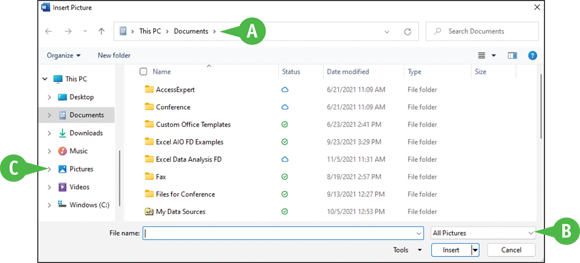
The Insert Picture dialog box appears.
![]() The folder you are viewing appears here.
The folder you are viewing appears here.
Note: Image files come in a variety of formats, including GIF, JPEG, and PNG.
![]() To browse for a particular file type, you can click
To browse for a particular file type, you can click ![]() and choose a file format.
and choose a file format.
![]() You can click in the folder list to navigate to commonly used locations where pictures may be stored.
You can click in the folder list to navigate to commonly used locations where pictures may be stored.
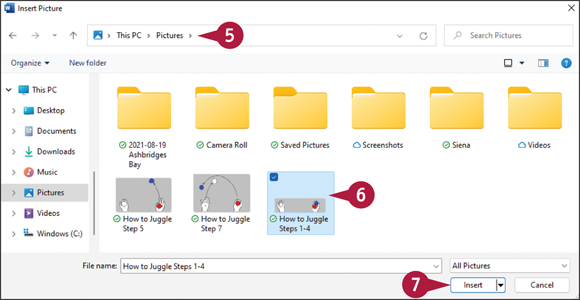
![]() Navigate to the folder containing the picture you want to add to your document.
Navigate to the folder containing the picture you want to add to your document.
![]() Click the picture you want to add.
Click the picture you want to add.
![]() Click Insert.
Click Insert.

![]() The picture appears in your document.
The picture appears in your document.
![]() The Picture Format contextual tab appears on the Ribbon; you can use these tools to format the selected picture.
The Picture Format contextual tab appears on the Ribbon; you can use these tools to format the selected picture.
![]() In the Picture Format tab, you can click Wrap Text to control text flow around the picture.
In the Picture Format tab, you can click Wrap Text to control text flow around the picture.
To remove a picture that you no longer want, you can click the picture and press ![]() .
.
Insert an Online Picture
If you want to illustrate a document but do not have an appropriate photo or other image stored on your computer’s hard drive, you can still add interest to your Microsoft 365 files by inserting a picture or clip art image from an online source. You can insert online pictures into a Word, Excel, PowerPoint, Publisher, Outlook, or OneNote document. Be careful when choosing an online picture and make sure that it either falls into the public domain, meaning you can use the picture without requiring permission, or you have written permission to use the picture.
Insert an Online Picture
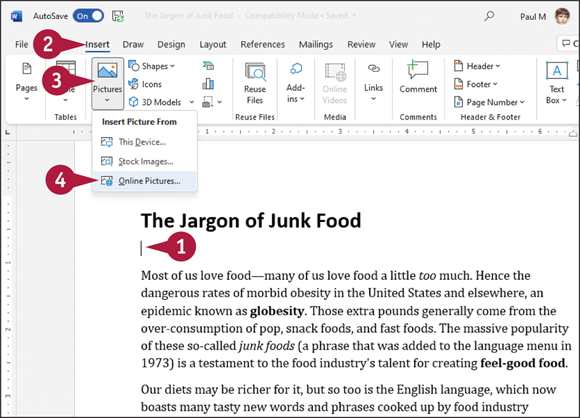
Note: If you are working in Word or Excel, switch to Print Layout view by clicking View and then Page Layout.
![]() Click in your document where you want to add a picture.
Click in your document where you want to add a picture.
Note: You can move the graphic to a different location after you insert it. See the section “Resize and Move Graphic Objects,” later in this chapter.
![]() Click the Insert tab.
Click the Insert tab.
![]() Click Pictures.
Click Pictures.
![]() Click Online Pictures.
Click Online Pictures.
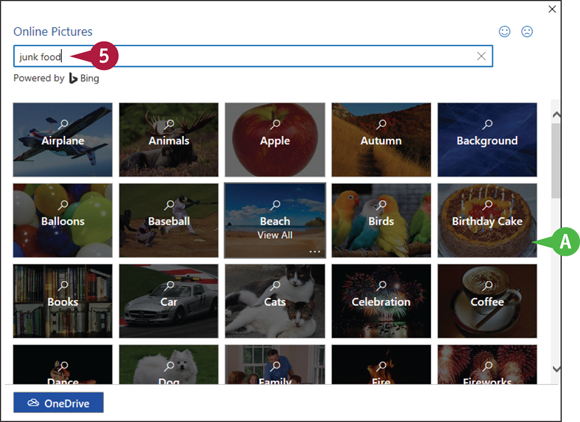
The Online Pictures dialog box appears.
![]() Click in the Search box and type a description of the kind of image you want.
Click in the Search box and type a description of the kind of image you want.
![]() You can also click a category to display images related to that subject.
You can also click a category to display images related to that subject.
![]() Press
Press ![]() .
.
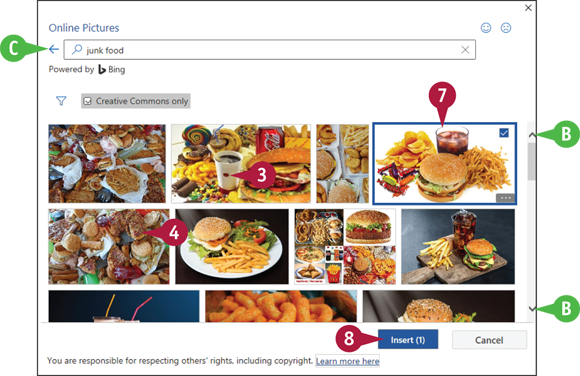
The results of your search appear.
![]() You can click the up and down arrows (
You can click the up and down arrows (![]() and
and ![]() ) to navigate through the search results.
) to navigate through the search results.
![]() You can click Back (
You can click Back (![]() ) to return to the Online Pictures dialog box and search for a different image.
) to return to the Online Pictures dialog box and search for a different image.
![]() Click the picture you want to add to your document.
Click the picture you want to add to your document.
![]() Click Insert.
Click Insert.
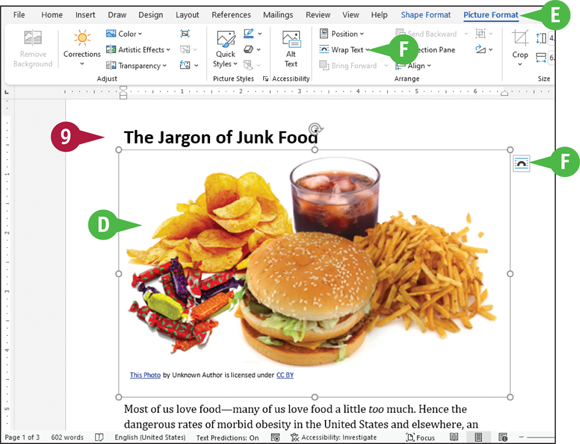
![]() The picture appears in your document.
The picture appears in your document.
![]() The Shape Format and Picture Format contextual tabs appear on the Ribbon; you can use these tools to format the selected picture.
The Shape Format and Picture Format contextual tabs appear on the Ribbon; you can use these tools to format the selected picture.
![]() You can click the Picture Format tab’s Wrap Text button or the Layout Options button (
You can click the Picture Format tab’s Wrap Text button or the Layout Options button (![]() ) to control how text flows around the picture.
) to control how text flows around the picture.
![]() When you finish working with your online picture, click anywhere else in the work area.
When you finish working with your online picture, click anywhere else in the work area.
Resize and Move Graphic Objects
If a picture or other type of image — which is also called a graphic object — is not positioned where you want it, you can move it. Similarly, if a graphic object or is too large or too small, you can resize it. When you select a graphic object, handles appear on each side of the graphic object; you can use these handles to resize it. Alignment guides — green lines — appear as you move a graphic object to help you determine where to place it. Once you have picked the spot for the graphic, the alignment guides disappear.
Resize and Move Graphic Objects
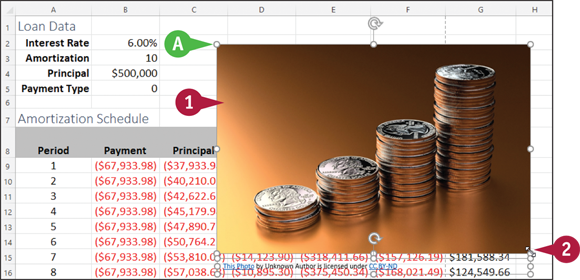
Resize a Graphic
![]() Click a graphic object.
Click a graphic object.
![]() Handles (
Handles (![]() ) surround the graphic.
) surround the graphic.
![]() Position the mouse over one of the handles (the app’s default mouse pointer changes to
Position the mouse over one of the handles (the app’s default mouse pointer changes to ![]() ,
, ![]() ,
, ![]() , or
, or ![]() ).
).

![]() Drag the handle inward or outward until the graphic object is the size you want (
Drag the handle inward or outward until the graphic object is the size you want (![]() ,
, ![]() ,
, ![]() , or
, or ![]() changes to
changes to ![]() ).
).
![]() Release the mouse button.
Release the mouse button.
The graphic object appears in the new size.
![]() Click outside the graphic object to cancel its selection.
Click outside the graphic object to cancel its selection.

Move a Graphic
![]() Click a graphic object.
Click a graphic object.
![]() Handles (
Handles (![]() ) surround the graphic.
) surround the graphic.
![]() Position the mouse over a graphic object or the edge of a text box (the app’s default mouse pointer changes to
Position the mouse over a graphic object or the edge of a text box (the app’s default mouse pointer changes to ![]() ).
).
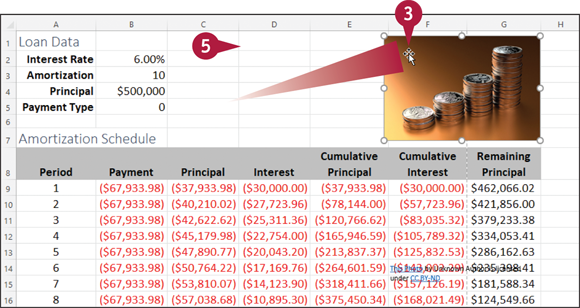
![]() Drag the graphic object to a new location.
Drag the graphic object to a new location.
![]() Release the mouse button.
Release the mouse button.
The graphic object appears in the new location.
![]() Click outside the graphic object to cancel its selection.
Click outside the graphic object to cancel its selection.
Understanding Graphics Modification Techniques
Besides inserting, moving, and resizing pictures as described in this chapter, you can insert and modify other types of graphic objects — shapes, screenshots, SmartArt, WordArt, and charts — in all Microsoft 365 apps except Access. The available graphic objects vary from app to app; the specific types of available graphic objects appear on the Insert tab of the program. You insert these objects using basically the same techniques you use to insert pictures.
You can modify an object’s appearance using a variety of Ribbon buttons that appear on a contextual tab specific to the type of graphic object you select.
Crop a Picture
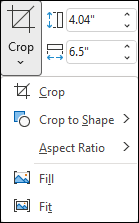
You can use the Crop tool to create a better fit, to omit a portion of the image, or to focus the viewer on an important area of the image. You can crop a picture, screenshot, or clip art image. When you crop an object, you remove vertical and/or horizontal edges from the object. The Crop tool is located on the Picture Format tab on the Ribbon, which appears when you click the object you want to crop.
Rotate or Flip a Graphic
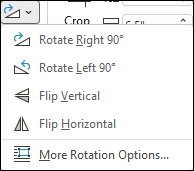
After you insert an object such as a piece of clip art or a photo from your hard drive into a Word document, you may find that the object appears upside down or inverted. Fortunately, Word makes it easy to flip or rotate an object. For example, you might flip a clip art image to face another direction, or rotate an arrow object to point elsewhere on the page. Or, for dramatic effect, you can rotate or flip pictures, clip art images, and some shapes. Keep in mind that you cannot rotate text boxes.
Correct Images
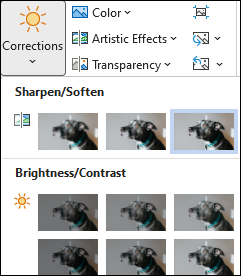
You can change the brightness and contrast of a picture, clip art, or a screenshot to improve its appearance, and you can sharpen or soften an image. Suppose, for example, the image object you have inserted in your Word, Excel, or PowerPoint file is slightly blurry, or lacks contrast. You find the image-correction tools on the Picture Tools Format tab on the Ribbon, which appears when you click to select the object to which you want to apply the effect.
Make Color Adjustments
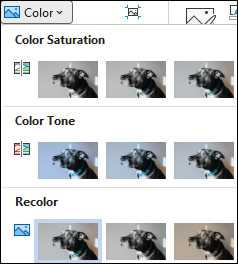
You can adjust the color of a picture, screenshot, or clip art image by increasing or decreasing color saturation or color tone. You can also recolor a picture, screenshot, or clip art image to create an interesting effect.
Color saturation controls the amount of red and green in a photo, whereas color tone controls the amount of blue and yellow.
Remove the Background of an Image

You can remove the background of a picture, screenshot, or clip art image. For example, suppose that you inserted a screenshot of an Excel chart in a Word document; the screenshot would, by default, include the Excel Ribbon. You can use the Remove Background tool in the Adjust group on the Picture Format tab to remove the Excel Ribbon and focus the reader’s attention on the chart.
Add an Effect
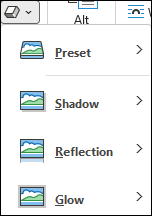
You can use tools to assign unique and interesting special effects to objects. For example, you can apply a shadow effect, create a mirrored reflection, apply a glow effect, soften the object’s edges, make a bevel effect, or generate a 3-D rotation effect. You can find these tools on the Picture Format tab of the Ribbon, which appears when you click to select the object to which you want to apply the effect. (Note that the Picture Effects tool is not available in Publisher.)
Apply a Style to a Graphic
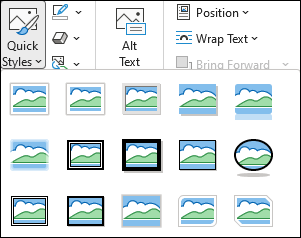
You can apply a predefined style to a shape, text box, WordArt graphic, picture, or clip art image. Styles contain predefined colors and effects and help you quickly add interest to a graphic. Applying a style removes other effects that you may have applied, such as shadow or bevel effects. Sample styles appear on the Picture Format or Shape Format tab when you click the More button (![]() ) in the Picture Styles or Shape Styles group.
) in the Picture Styles or Shape Styles group.
Add a Picture Border or Drawing Outline
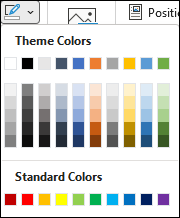
You can add a border to a picture, shape, text box, WordArt graphic, clip art image, or screenshot. Using the Picture Border or Shape Outline tool, which appears on the Picture Format or Shape Format tab, you can control the thickness of the border, set a style for the border — a solid or dashed line — and change the color of the border.
Apply Artistic Effects
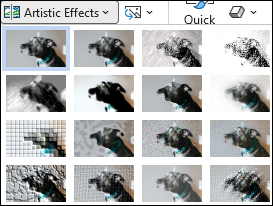
You can apply artistic effects to pictures, screenshots, and clip art to liven them up. For example, you can make an image appear as though it was rendered in marker, pencil, chalk, or paint. Other artistic effects might remind you of mosaics, film grain, or glass. You find the Artistic Effects button on the Picture Format tab, which appears when you click to select the object to which you want to apply the effect.
